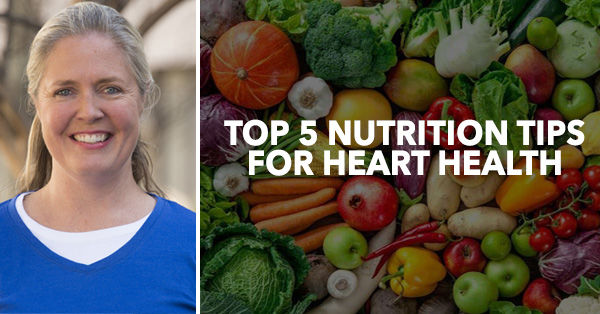Top 5 Nutritional Tips for Patients Living With Heart Disease
Written By: Adam Pick, Patient Advocate, Author & Website Founder
Medical Expert: Mandy Hillstrom, EdD, MPH, RDN
Page Last Updated: May 13, 2025
I receive many patient questions about nutrition and heart disease. That said, I recently asked Mandy Hillstrom, EdD, MPH, RDN if she had any nutritional tips for our community. Here's the heart healthy advice that Mandy, who is a professor at California State University Los Angeles, and Jemima Faisca, MS, one of her students, sent me.
 Mandy Hillstrom, EdD, MPH, RDN (California State University Los Angeles)
Mandy Hillstrom, EdD, MPH, RDN (California State University Los Angeles)
You are likely aware that heart disease is the number one killer of both men and women in the U.S. (1,2). Did you know that there are specific foods that you can eat today that are widely known to help reduce your risk?
You may have noticed some foods and supplements gain attention for a short while, then fizzle out. However, there are a number of specific foods and beverages which have withstood the test of time and the rigors of scientific studies. Most of these foods fit into whatever your nutritional pattern is and there is no need to make major dietary changes. They may not be fancy or over-hyped, but they are guaranteed to help keep your ticker working better.
1. Eat Nuts!
Yes, eat any type of nut, as often as possible. Nuts are packed with healthy fats, protein, fibers, vitamins and minerals. Consumption of any type helps with heart health through a variety of mechanisms including through overall reduction of cholesterol, reducing inflammation, by working as an antioxidant, and by helping with weight loss. A recent student found that peanut and tree nut (pistachio, cashews, almonds, and Brazil nuts) consumption at least twice a week and walnut consumption at least once a week was related to a 13-19% lower risk of total cardiovascular disease and a 15-23% lower risk of coronary heart disease (3).
Nuts are calorically dense, so if you are trying to maintain or lose weight, make sure to eat a reasonable portion (usually 1 serving on the food label). Easy ways to add more nuts: Add almond slivers to your oatmeal, pack nuts for snacks, add walnuts to salads, and include them in your breads and cookies. Look for lightly salted or even unsalted nuts. Peanut and nut butters count too!
2. Fruits and Veggies to the Rescue?
Eat fruits and vegetables frequently and ideally six or more servings a day. It seems obvious to list eating more fruits and vegetables, but the data is so persuasive, it cannot be left off this list. Almost all fruits and vegetables offer some form of protection and multiple health benefits.
Some of the most compelling research specifically geared towards cardiovascular health has shown the following fruits and vegetables to be the biggest winners: avocados, berries, tomatoes, and leafy greens.
Berries (any and all!) as well as avocados have been demonstrated to reduce LDL (also known as “bad”) cholesterol, a leading risk factor for cardiovascular disease (6, 8). It’s easy to add berries to oatmeal or yogurt, or enjoy them as a healthy snack or dessert, and it’s almost impossible not to find avocado toast on most menus these days!
Green leafy vegetables are also a heart healthy food. These include broccoli, kale, cabbage, cauliflower, bok choy, collard greens, and more. They have been demonstrated over multiple studies to reduce cardiovascular disease by as much as 15% (7).
Finally, tomatoes offer another type of protection in the form of the antioxidant lycopene. Lycopene is found in high concentration in tomatoes and can help reduce inflammation which exacerbates heart disease. This lycopene is easier for the body to absorb if the tomatoes have been cooked, so lightly stewed tomatoes over pasta or in a soup would be an easy way to incorporate this into your diet (9).
3. Whole Grains For Whole Heart Health
Choose whole grains when possible. This includes whole wheat bread and pasta, brown rice, bran cereals, oatmeal, quinoa, corn, and rye. Just make sure to read the labels on some items with more ingredients such as cereals and bread. The goal is for the whole grain item to appear first on the list, and for any added sugar to be as far down on the list as possible, and not be high-fructose corn syrup.
Also make sure to understand that whole grain and multi-grain are different. If something is whole grain, the grain has been left intact which means all the fiber and nutrient providing components are still there. Remember, something can be made up of multiple grains (multi-grain) without any of them actually being whole. To double check, you’ll want to look at that ingredient list again!
Whole grains have been demonstrated to lower the risk of cardiovascular disease by over 20% by reducing total and LDL cholesterol. The fiber in the whole grains also helps to control blood sugar and keep your digestive system moving, which in turn contributes to a healthy weight or weight loss, which further decreases risk of heart disease. The current minimum recommendation for whole grains is 3 servings a day, with 5-8 being the optimal range depending on your age, gender, and activity level. Go to www.choosemyplate.gov to find the level that is right for you, as well as exactly what counts as a serving of whole grains. (4,5)
4. The Right Fats Fight Heart Disease!
Healthy fats, and particularly oils, are also helpful in the fight against cardiovascular disease. Two of the major oils that consistently demonstrate winning results are olive and fish. Olive oil has been shown to reduce cardiovascular disease by up to 35% and cardiovascular deaths by 48%. Furthermore, for every 10 grams of olive oil added a day (a little under one tablespoon), the risk of disease and death decreased by 10% and the risk of death by 7% (10). Fish oils, through the healthy fat within them called omega-3s, function both by reducing inflammation and by lowering triglycerides, therefore contributing to overall heart health (11). Fish oils can be consumed either through fatty fish, such as salmon, tuna, sardines, and herring, or through supplements.
5. Health Benefits of Tea, Chocolate & Wine?
Now it’s time for some fun stuff!
There are a whole host of foods you probably already enjoy that, good news, are working to protect your heart! These foods are not necessarily critical for a healthy diet, but can be helpful in small amounts. However, there’s also evidence to suggest that we need to be careful not to overdo it.
First, let’s discuss green tea. Green tea has been demonstrated to function as an antioxidant and reduce blood pressure (12). Of course, green tea does contain caffeine, for which people have different tolerances. Ideally, green tea should be enjoyed as is, and not with too many added sweeteners.
Next is dark chocolate. This also functions as an antioxidant and frequent dark chocolate consumption (2-5 times a week) has been associated with up to a 37% reduction in cardiovascular disease (13). The obvious caution here is that all chocolate contains high amounts of sugar and saturated fat, but when enjoyed in moderation, high quality dark chocolate can make for a delicious and healthy dessert option.
Finally, wine has been demonstrated to have some protective effects on cardiovascular disease as well. This particularly refers to red wine and is thought to be due to a compound found in the grapes called resveratrol. Similar to antioxidants, resveratrol functions to reduce oxidative stress and is effective when consumed in moderation (14). This generally translates to 1 drink (6 ounces) a day for women and 1-2 drinks a day for men. Moderation is important as the detrimental effects of over-consumption of alcohol will override any benefits from the resveratrol, but a glass of wine with a square of dark chocolate can be a heart healthy (and completely guilt free!) way to relax after a long day! Should people that don’t currently drink wine start? That’s not recommended, and resveratrol can also be found in the skins of grapes, blueberries and raspberries, and in peanuts (see #1 above if you’re still not convinced how great nuts are!!!).
Choosing heart healthy foods and beverages to include in your daily diet really will make a lifelong difference. And don’t forget two more important keys to a long and healthy life -- regular exercise and quitting smoking. Bon appetit!
Thanks Mandy & Jemima!
On behalf of our patient community, I want to thank Mandy and Jemima for taking the time to share their clinical experience and research with us. If you would like to contact Mandy, please email her at mandyhillstromrd@gmail.com.
It's lunch time. And, I'm hungry. These tips are going to help me have a healthy and yummy meal!
You May Also Like:
- Mick Jagger's Heart Surgery: 5 Facts to Know
- Anatomy & Function of Your Heart
- How Does Aortic Valve Stenosis Progress?
REFERENCES
1. Centers for Disease Control and Prevention. (2015). Leading Causes of Death in Males, 2015. Retrieved from https://www.cdc.gov/healthequity/lcod/men/2015/race-ethnicity/index.htm
2. Centers for Disease Control and Prevention. (2015). Leading Causes of Death in Females, 2015. Retrieved from https://www.cdc.gov/women/lcod/2015/race-ethnicity/index.htm
3. Guasch-Ferré M., Liu X., Malik V.S., Sun Q., Willett W.C., Manson J.E.,… Bhupathiraju S.N. (2017) Nut Consumption and Risk of Cardiovascular Disease. Journal of the American College of Cardiology, 70(20), 2519-2532. doi: 10.1016/j.jacc.2017.09.035.
4. United States Department of Agriculture. (2017). All About the Grains Group, 2017. Retrieved from https://www.choosemyplate.gov/grains
5. Ye E.Q., Chacko S.A., Chou E.L., Kugizaki M., & Liu S. (2013). Greater Whole-Grain Intake Is Associated with Lower Risk of Type 2 Diabetes, Cardiovascular Disease, and Weight Gain. The Journal of Nutrition, 143(9), 1524. https://doi.org/10.3945/jn.113.180281
6. Huang, H., Chen, G., Liao, D., Zhu, Y., & Xue, X. (2106) Effects of Berries Consumption on Cardiovascular Risk Factors: A Meta-analysis with Trial Sequential Analysis of Randomized Controlled Trials. Scientific Reports, 6, 23625. http//doi.org/10.1038/srep23625.
7. Pollock, R.L. (2016). The effect of green leafy and cruciferous vegetable intake on the incidence of cardiovascular disease: A meta-analysis. JRSM Cardiovascular Disease, 5, 2048004016661435. http://doi.org/10.1177/2048004016661435.
8. Wang, L., Bordi, P.L., Fleming, J.A., Hill, A.M., & Kris-Etherton, P.M. (2015) Effect of a moderate fat diet with and without avocados on lipoprotein particle number, size, and subclasses in overweight and obese adults: a randomized, controlled trial. Journal of the American Heart Association: Cardiovascular and Cerebrovascular Disease, 4(1), e001355. http://doi.org/10.1161/JAHA.114.001355.
9. Riccioni, G., Mancini, B., Di Ilio, E., Bucciarelli, T., & D’Orazio, N. (2008). Protective effect of lycopene in cardiovascular disease. European Review for Medical and Pharmacological Sciences, 12, 183-190. Retrieved from https://www.researchgate.net/profile/Nicolantonio_DOrazio/publication/23168447_Protective_
effect_of_lycopene_in_cardiovascular_disease
/links/02e7e515ee7142c494000000/Protective-effect-of-lycopene-in-cardiovascular-disease.pdf
10. Guasch-Ferré, M., Hu, F.B., Martínez-González, M.A., Fitó, M., Bulló, M., Estruch, R.,…Salas-Salvadó, J. (2014). Olive oil intake and risk of cardiovascular disease and mortality in the PREDIMED Study. BMC Medicine, 12, 78. https://doi.org/10.1186/1741-7015-12-78. 11.
11.Weitz, D., Weintraub, H., Fisher, E., & Schwartzbard, A.Z. (2010). Fish Oil for the Treatment of Cardiovascular Disease. Cardiology in Review, 18(5), 258-263. http://doi.org/10.1097/CRD.0b013e3181ea0de0.
12. Bogdanski, P., Suliburska, J., Szulinska, M., Stepien, M., Pupek-Musialik, D., & Jablecka, A. (2012). Green tea extract reduces blood pressure, inflammatory biomarkers, and oxidative stress and improves parameters associated with insulin resistance in obese, hypertensive patients. Nutrition Research, 32(6), 421-427. https://doi.org/10.1016/j.nutres.2012.05.007.
13. Li, H., & Förstermann, U. (2012). Red Wine and Cardiovascular Health. Circulation Research, 111(8), 959-961. Retrieved from https://www.ahajournals.org/doi/abs/10.1161/circresaha.112.278705




